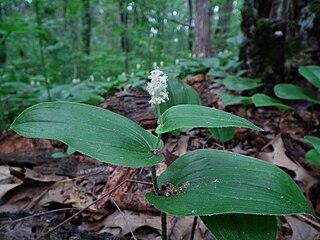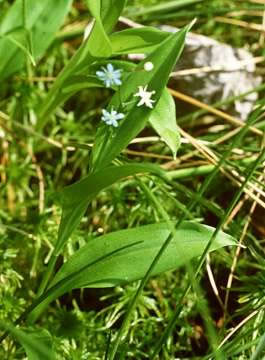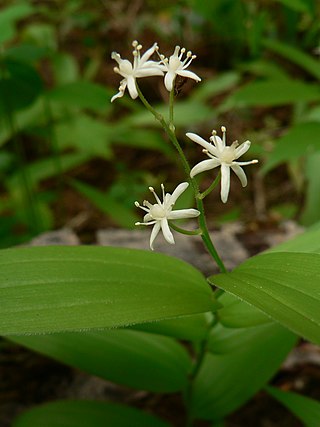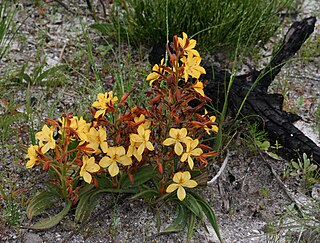
Maianthemum includes the former genus Smilacina and is a genus of perennial herbaceous flowering plants with fleshy, persistent rhizomes. It is widespread across much of North America, Europe and Asia, and may be terrestrial, aquatic or epiphytic. It is characterized by simple, unbranched stems that are upright, leaning or hanging down and have 2–17 foliage leaves. Leaves are simple and may clasp the stem or be short-petiolate. The inflorescence is terminal and either a panicle or a raceme with few to many pedicelate flowers. Most species have 6 tepals and 6 stamens; a few have parts in 4s. Tepals are distinct in most species and all of similar size. Flowers are spreading, cup-shaped or bell-shaped and usually white, but lavender to red or green in some species. Fruits are rounded to lobed berries containing few to several seeds.

Maianthemum canadense is an understory perennial flowering plant, native to Canada and the northeastern United States, from Yukon and British Columbia east to Newfoundland, into St. Pierre and Miquelon. It can be found growing in both coniferous and deciduous forests. The plant appears in two forms, either as a single leaf rising from the ground with no fruiting structures or as a flowering/fruiting stem with 2-3 leaves. Flowering shoots have clusters of 12–25 starry-shaped, white flowers held above the leaves.

Maianthemum racemosum, the treacleberry, feathery false lily of the valley, false Solomon's seal, Solomon's plume or false spikenard, is a species of flowering plant native to North America. It is a common, widespread plant with numerous common names and synonyms, known from every US state except Hawaii, and from every Canadian province and territory, as well as from Mexico.

Maianthemum trifolium is a species of flowering plant that is associated with extremely wet environments and is native to Canada and the northeastern United States as well as St. Pierre and Miquelon and Asia (Siberia).

Wachendorfia is a genus of perennial herbaceous plants that is assigned to the bloodroot family. The plants have a perennial rootstock with red sap. From the rootstock emerge lance- or line-shaped, sometime sickle-shaped, pleated, simple leaves set in a fan, that are flattened to create a left and right surface rather than an upper and lower surface. The leaves die when the seeds are shed in three of the species, and are perennial in one species. The rootstock also produces flowering stems annually that carry a panicle of zygomorphic, yellow or yellowish flowers in two distinct forms, one with the style and one stamen bent to the right and two stamens to the left, and vice versa. The fruit opens with three valves and each contains a single, hairy seed. All species only occur in the fynbos biome in the Cape provinces of South Africa.

Maianthemum stellatum is a species of flowering plant, native across North America. It has been found in northern Mexico, every Canadian province and territory except Nunavut, and from every US state except Hawaii and the states of the Southeast. It has little white buds in the spring, followed by delicate starry flowers, then green-and-black striped berries, and finally deep red berries in the fall.

Paris polyphylla is an Asian species of flowering plant native to China, the Indian Subcontinent, and Indochina. It produces spider-like flowers that throw out long, thread-like, yellowish green petals throughout most of the warm summer months and into the autumn. In the fall, the flowers are followed by small, scarlet berries. It is a perennial, which slowly spreads, is fully hardy in Britain, and survives in leafy, moist soil in either complete or partial shade.

Maianthemum paniculatum is a perennial flowering plant; a species of monocot found from Mexico to Panama. It is often associated with montane environments and is found primarily in forest openings and along roadsides.

Corsia ornata is a species of flowering plant in the genus Corsia of the small family Corsiaceae, part of the monocot order Liliales. They are saprophytes (Myco-heterotrophs), lacking the ability to photosynthesise, being dependent on other organisms for their nutrition. The plant lives underground, sending up purplish stems above ground in order to flower. The leaves are reduced to scales. One of the six petal-like tepals named the labellum, is specialised, being enlarged and hanging protectively over the reproductive organs. It was discovered in New Guinea in 1875, but has since been sighted in Queensland, Australia.

Wachendorfia thyrsiflora, the marsh butterfly lily, is a plant species of 0.6–2.5 m (2.0–8.2 ft) high when flowering, that has been assigned to the bloodroot family. It is a large to very large evergreen perennial plant with an underground rootstock with clusters of roots produced at the nodes. The rootstock has a distinctive red colour that results from so-called arylphenalenone pigments. The sturdy, entire and broadly sword-shaped leaves have laterally flattened and pleated leaf blades. The golden yellow flowers are set a dense cylindrical panicle on a tall firm stalk. Flowering occurs from spring until mid-summer.
Maianthemum amoenum is a perennial flowering plant, growing as an epiphyte on trees in cloud forests from Mexico south to Honduras.
Maianthemum monteverdense is a perennial flowering plant of restricted distribution. It grows as an epiphyte on trees in high cloud forests of 1600 m + elevation from Nicaragua to Costa Rica.
Maianthemum paludicola is a perennial flowering plant. It is a rare terrestrial herb, endemic to Costa Rica. It has only been found in high-elevation bogs and wetlands and was first described in 1986.
Maianthemum macrophyllum is a perennial flowering plant. It is a rare epiphtic herb endemic to Veracruz and Oaxaca, Mexico and is known only from primary cloud forests, usually growing on limbs of oaks or sweetgum.

Maianthemum scilloideum is a perennial flowering plant. It is a terrestrial forest herb from southern Mexico and Guatemala and also reported from Honduras.
Maianthemum flexuosum is a perennial, terrestrial understory herb of cloud forests from southern Mexico to Nicaragua. It has been found at sites from 1300 to 2800 m elevation.
Maianthemum salvinii is a rare perennial, epiphytic herb found in southern Mexico and Guatemala.
Maianthemum mexicanum is a perennial, terrestrial herb found as an understory species in moist forests. It is endemic to west-central Mexico.

Wachendorfia paniculata is a species of plant of 10–90 cm (3.9–35.4 in) high, that emerges during the winter from an underground rootstock. It has entire, sword-shaped, mostly hairy, line- to lance-shaped, straight or sickle-shaped leaves, set in a fan at ground level with a lax to dense panicle consisting of pale apricot to yellow mirror-symmetric flowers with six tepals, three stamens and a undivided style that curves either to the right or left. The species is assigned to the bloodroot family. Flowering occurs between August and December at sea level, and until early February at high altitude, with a distinct peak from September to November. It can only be found in the Cape provinces of South Africa. Like other species of Wachendorfia, it is called butterfly lily in English and rooikanol or spinnekopblom in Afrikaans, and this species in particular is also called koffiepit in Afrikaans.

Babiana bainesii is a species of geophyte of 15–25 cm (5.9–9.8 in) high that is assigned to the family Iridaceae. It sometimes grows in tufts. The approximately upright leaf blades appear directly from the ground, are narrow, sword- to line-shaped and have a left and right surface, rather than an upper and lower surface, and far exceed the flowers in length. The leaf blades are pleated. The inflorescence stem is fully underground and often branched. It contains two to eight blue, violet or mauve mirror-symmetrical flowers comprising six tepals. The lower lateral tepals are adorned with white markings that contrast strongly against the background colour. The three stamens are crowding under the dorsal tepal. Flowering occurs between February and May. The flowers are often sweetly scented. B. bainesii has a wide distribution and occurs in Botswana, Namibia, South Africa, southernmost Zambia and Zimbabwe.












